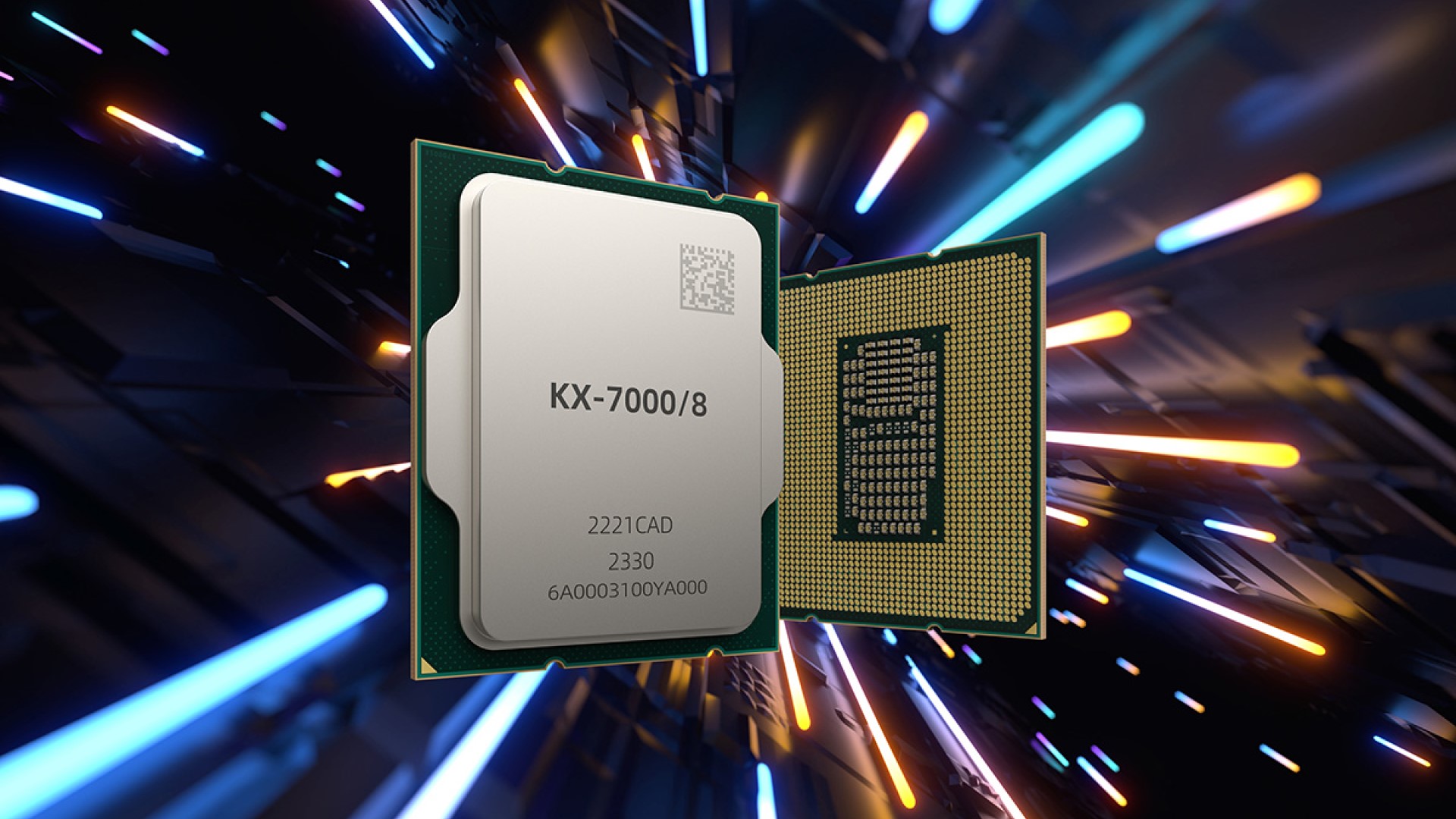
When Zhaoxin, a joint venture between Via Technologies and Shanghai Municipal Government, introduced its KaiXian KX-7000 series of x86 processors in late 2023, it implied that the new CPUs will offer tangible performance improvements over its predecessors as they were based on a brand-new microarchitecture. While the new chips are probably faster than their predecessors, they are still years behind AMD and Intel CPUs.
PC Watch this week put Zhaoxin’s eight-core KaiXian KX-7000/8 processor (Century Avenue, 8C/8T, 4MB L2, 32MB L3, two DDR4-3200/DDR5-4800 channels, 24 PCIe 4.0 lanes) into a test against AMD’s six-core Ryzen 5 5600G (Zen 3, 6C/12T, 3.90 GHz – 4.40 GHz, 3 MB L2, 16 MB L3, two DDR4-3200 channels, 16 PCIe 3.0 lanes, 65W, released in 2021) and Intel’s quad-core Core i3-8100 (Coffee Lake, 4C/4T, 3.60 GHz, 6 MB cache, two DDR4-2400 channels, 16 PCIe 3.0 lanes, 65W, released in Q4 2017). While these processors belong to different years and were even positioned differently when released, they operate at the same clock speed, which gives an idea about potential of the latest Zhaoxin microarchitecture (allegedly developed by Centaur Technology).
| Benchmark | KiaXian KX-7000/8 | Core i3-8100 | Ryzen 5 5600G |
| CPU-Z | ST | 335.9 | 422.2 | 615.3 |
| CPU-Z | MT | 2517.2 | 1618.4 | 4790.5 |
| Cinebench R23 | ST | 584 | 953 | 1435 |
| Cinebench R23 | MT | 3595 | 3585 | 10387 |
| 3DMark | Time Spy | 42 | 469 | 1440 |
| 3DMark | Fire Strike | 86 | 1150 | 3662 |
| 3DMark | Night Raid | 936 | 5771 | 16147 |
| 3DMark | Time Spy | RX 6400 | 3512 | 3504 | 3735 |
| 3DMark | Fire Strike | RX 6400 | 8632 | 9140 | 10327 |
| 3DMark | Night Raid | RX 6400 | 26506 | 24076 | 34204 |
| Dragon Quest X | iGPU | 2518 | 4704 | 12137 |
| Dragon Quest X | RX 6400 | 4808 | 7387 | 9505 |
| Final Fantasy XIV | RX 6400 | 6578 | 7186 | 8521 |
| Power Consumption | CB R23 | 112W | 64W | 102W |
| Power Consumption | CB R24 | 38W | 23W | 24W |
PC Watch tested Zhaoxin’s KaiXian KX-7000/8 in a variety of benchmarks, some artificial, others are more real-world applications.
When it comes to single-thread CPU performance via CPU-Z benchmark, the KX-7000/8 scored 335.9, significantly lower than the Intel Core i3-8100 (422.2) and AMD Ryzen 5 5600G (615.3). Since the KX-7000/8 has eight cores, it achieved a score of 2517.2 in multi-thread CPU-Z benchmark, outperforming the Core i3-8100 (1618.4) but falling short of the Ryzen 5 5600G (4790.5).
To a large degree, such behavior defines the capabilities of the KX-7000/8: it can beat rivals in workloads that take advantage of eight cores, but it can never beat them in applications that require superior single-thread performance.
In Cinebench R23, the KX-7000/8 scored 584 points in single-thread benchmark, which is significantly lower than both the Intel Core i3-8100 (953) and AMD Ryzen 5 5600G (1,435). In the multi-core Cinebench R23 test, the KaiXian KX-7000/8 achieved 3,595, roughly on par with the Core i3-8100 (3,585) but far behind the Ryzen 5 5600G (10,387).
When it comes to PCMark 10 Express, the Zhaoxin KX-7000/8 exhibits lower performance across all categories compared to the AMD Ryzen 5 5600G and Intel Core i3-8100. The Chinese CPU struggles particularly with productivity, spreadsheet, and app scores, which pretty much indicates limited multitasking capability in heavy workload scenarios. While it may be sufficient for very basic tasks, it is outclassed by both competitors in all aspects.
Just like its competitors, the KaiXian KX-7000/8 has a built-in graphics core, though its performance is so low that it does not really make sense to discuss it, but to focus on performance of the CPU in gaming applications when it is equipped with an external Radeon RX 6400 graphics card.
In 3DMark, the Zhaoxin KX-7000/8 demonstrates competitive performance with the Core i3-8100 in two scenarios (e.g., Time Spy and Night Raid) and outperforms it in one case (Night Raid), but generally falls behind of the Ryzen 5 5600G in all tests. But this is rather an exception than a rule.
The KX-7000/8 is significantly behind both of its rivals in the Dragon Quest X benchmark even when it is equipped with an external GPU, which highlights its low single-thread performance. The same applies to the Final Fantasy XIV benchmark: the new CPU is barely a good choice for gaming.
Where Zhaoxin’s KaiXian KX-7000/8 can actually shine are sequential read and sequential write SSD speeds as unlike its rival, it has PCIe 4.0 lanes and therefore it can work with PCIe 4.0 x4 drives at full speed.
While it is hard to draw conclusions based on one review and a limited number of benchmarks, it looks like Zhaoxin’s latest microarchitecture is still years behind those of AMD and Intel in terms of single-thread performance. It is also behind rivals in terms of power consumption and efficiency. Nonetheless, now that Chinese government agencies and state-controlled companies are told not to buy PCs with foreign processors inside, they will buy Zhaoxin-based machines with not so many questions asked.
Read full post on Tom’s Hardware
Discover more from Technical Master - Gadgets Reviews, Guides and Gaming News
Subscribe to get the latest posts sent to your email.








